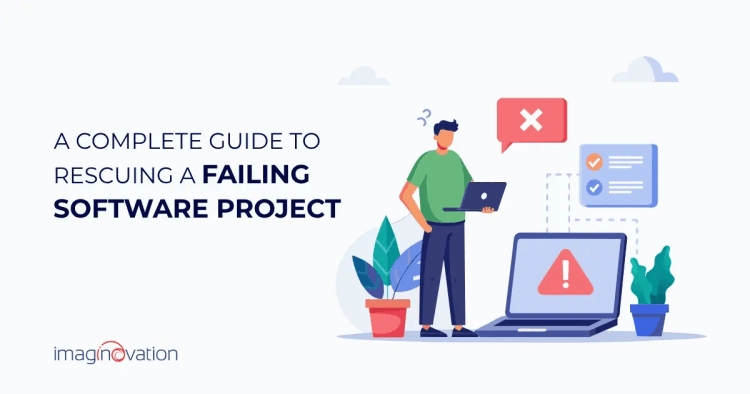To estimate the cost of building a website or an app, use our app cost calculator tool.
You've worked hard on a software project for months, but things aren't going well. The code is behind schedule, there are bugs, and team members keep leaving.
You're frustrated and unsure of the project's value. Your customer seems unhappy and is pressuring you to change direction. You notice a lack of clear vision and signs of scope creep. Developer morale is crashing.
Recognizing all these signs of a failing project early on is crucial.
Project failure happens, but with the right approach, you can rescue failing software projects without starting from scratch.
There are strategies to rescue failing software projects. Follow these steps carefully, and your project can succeed.
In this article, we'll explore common reasons for project failure and offer tips on implementing a recovery plan.
Identifying the Signs of a Failing Project
While there's no guaranteed magic potion for a successful project, there are proven methods that can increase your chances of having one. Start by identifying common problems and addressing them proactively**.** During the project, stay alert for early warning signals and be open to making necessary changes or seeking external help.
When your software project starts missing deadlines or going over budget, it's a red flag. It is super important to catch all the signs of a failing project early to avoid further problems.
Here are the warning signs that your software project may be going off track -
1. Delays and Missed Deadlines
If your software development project keeps missing its deadlines, that's a clear sign of trouble. It could mean the planning could have been better, expectations were unrealistic, or the team is underperforming.
2. Scope Creep
Changing the project scope too often without adjusting timelines and resources is a warning sign. It's called 'scope creep' and can cause overwork, increased costs, and delivery delays.
3. Quality Issues with the Deliverables
If the project consistently produces sub-par results, with numerous bugs and errors, it clearly indicates that the product's performance is low and the project is veering off track.
4. Lack of a Signed-off BRD (Business Requirement Document)
A clearly approved BRD is vital to ensure the project is properly reviewed and well-understood by all stakeholders (client, internal solution team, and the delivery team). Not having this signed-off document is a red flag and an early sign of future failures.
5. Inconsistent Management Directives
When project leadership starts giving inconsistent and changing directives, it shows that the project is headed for trouble. If the project lacks direction or fails to maintain a consistent course, it won't achieve its goal.
6. Lack of Progress Visibility
A lack of progress visibility signals a project in trouble. When no one is aware of who is taking care of what and when there is limited insight into project status and milestones, it is challenging for people to stay on track and understand their tasks.
7. Lack of Communication
Poor and inadequate communication within the team or with stakeholders can lead to misunderstandings, misalignments, and project setbacks. Watch out for this sign and take appropriate action.
8. Resource Constraints
A consistent lack of resources, whether people or technology, can be a warning sign for your project. Such scarcity often causes delays in completing tasks or compromises the quality of work as your team becomes overworked.
9. Declining Team Morale
If your team is demotivated, stressed, or unproductive, it may be a red flag for the project. Low team morale can lead to lower productivity and increased turnover rates.
10. Budget Overrun
Budget overrun is a red flag that can signal deeper issues within project management, planning, and execution. Unforeseen complexities, scope changes, or an incomplete understanding of requirements all contribute to inaccurate estimations and budget overrun.
11. Simple Things Take Long
If your team struggles with small changes like changing colors or moving a text box, it's a sign that big changes will take even longer. Overcomplicating simple changes and bad architectural decisions can make even the smallest tasks difficult.
12. Poor Testing Plan
The product's launch is risky if testing is overlooked or not included in development. It will either have too many bugs or not meet user expectations.
Conducting a Project Audit
After identifying the signs of a failing project, a project audit can be the next crucial step.
Project audit aligns your IT department with business goals by reviewing the technical delivery process and closing tech gaps. Remember, project inefficiencies can increase costs, complicate maintenance, and lower employee satisfaction.
The audit should identify roadblocks, evaluate team performance, and address concerns about the tech stack, code quality, productivity, and UX/UI usability.
Conduct an audit if your project is off track or has source code quality issues. It should be conducted even when you notice tech gaps or when you want to boost team productivity and improve user experience.
Follow these steps to conduct an effective project audit for software development rescue:

1. Define the Audit Objective
Start by outlining the project audit goals. Decide which project aspects you will assess: budget control, adherence to deadlines, risk management, quality assurance, or communication with stakeholders.
2. Gather Project Documentation
Collect project documents such as the project scope, project plan and schedule, risk register, budget records, progress reports, communication plan, communication log, team structure, and meeting minutes. These documents offer vital details about project timelines, finances, risks, team roles, etc., helping you identify discrepancies, inefficiencies, and areas for improvement during the audit.
3. Evaluate Project Documentation Thoroughly
Ensure all project documents are complete, up-to-date, and consistent. Check to see if they follow project standards, best practices, frameworks, and methodologies. Also, verify that all project requirements and changes can be traced through the documentation.
4. Assess the Team’s Performance
Assess team performance by comparing productivity to planned deliverables, such as actual output against initial targets. Evaluate collaboration, ensure effective skill utilization, and check team satisfaction and motivation to monitor morale. This helps identify areas for improvement and adjustments to enhance productivity.
5. Review Stakeholder Expectations
Interact with project stakeholders such as sponsors, clients, team members, and other experts. Gather their feedback on project success factors, expectations, concerns, and audit focus areas. Align project outcomes with stakeholder expectations. Analyze stakeholder feedback to assess project progress and outcomes.
6. Identify Any Technical Issues
Examine the project's technical infrastructure, tools, and processes. Analyze technical specifications, hardware and software compatibility and review the codebase for maintainability and efficiency. This includes identifying technical debt, assessing system architecture, and evaluating UX/UI for user-friendliness and functionality.
7. Analyze Audit Findings
Analyze the audit findings. Identify any deviations from the project plan or goals. Figure out inefficient or ineffective processes. Document any risks or issues that could affect project success.
8. Summarize Report
Prepare a comprehensive report by compiling all findings in detail. Offer practical recommendations to fix the issues. Create an action plan with timelines and responsibilities for implementing the recommendations. And present this report to the key stakeholders.
By following this process, you can gain valuable insights and take corrective actions to steer the project toward success.
Also Read: Developing an Intelligent Document Processing Platform
Reevaluating Project Goals and Objectives
Are your software project goals still relevant and aligned with evolving stakeholder and business needs? If not, it's time to reevaluate and possibly redefine them.
For example, changes in technology may necessitate a shift in project focus, or user feedback may highlight the need to adjust objectives to enhance user experience. Unforeseen technical limitation during development is another reason to consider reevaluating your project goals.
Regularly reassessing and aligning project goals with stakeholder expectations and business needs increases the likelihood of successful outcomes and stakeholder satisfaction. This ensures your strategies remain effective despite any changes and disruptions.
Here’s what you must do to align these goals with stakeholder expectations and business needs -
- Review Your Project Vision and Purpose: Regularly revisit the project vision and purpose to ensure they align with current stakeholder needs and expectations. Confirm that the goals continue to provide value and benefits in light of any changes or developments.
- Recognize the Need for Adjustments: Be proactive in identifying when adjustments are needed, such as in response to market changes, new competitors, or shifting customer preferences. Timely recognition of these changes allows for swift realignment of project goals.
- Revisit tech choices: When rescuing a software project, evaluate and update technology choices made at the start. Projects lasting years may be based on outdated tools. Consider switching old frameworks to modern ones like for improved performance. Upgrading tools to newer versions is easier than rewriting code from scratch. Moreover, modern frameworks offer tools to transition smoothly.
- Identify Evolving Stakeholder Needs: Engage with stakeholders to understand their evolving needs and ensure the project goals reflect these requirements. This alignment helps maintain relevance and supports the business objectives.
- Collaborate with Stakeholders: Keep stakeholders informed about any changes and explain how the goals were reevaluated. Address their concerns, questions, and expectations to build trust and ensure everyone is aligned with the new direction.
- Set Realistic and Achievable Goals: Break down larger goals into smaller, manageable tasks and set clear milestones. This approach makes objectives more attainable and helps avoid deviations from the planned course.
- Do not underestimate the workload, as taking on too much can lead to multiple problems.
- Be cautious about setting unrealistic deadlines by overestimating the time available. This can result in rushed work and demotivation. While guaranteeing fast deliveries may attract new clients, ensure it doesn't compromise quality
- Be mindful of overspending on unfinished projects, which can impact future endeavors and team morale. Remember that financial constraints can affect everyone involved, potentially leading to dissatisfaction among team members.
- Have a Milestone-Based Project Plan: Develop a project plan with well-defined milestones and functionalities. Milestones are hard coded dates and functionalities to be delivered on that date. Review progress daily and conduct regular stand-up meetings to identify and address any gaps or issues promptly.
- Identify Key Team Resources: Ensure that key team members, such as Business Analysts, Project Managers, Developers, and Testers, are onboarded from day one. Not having a complete team at the start is a significant risk that needs to be mitigated.
- Governance and Communication: Establish a governance framework and regular communication channels. Hold consistent governance calls and keep clients updated on dependencies, such as access to development and testing environments, to prevent project delays due to missed obligations.
Open and transparent communication with stakeholders, regular meetings, and status updates help understand evolving requirements and changing priorities. Collaborating on defining Key Performance Indicators (KPIs) and success metrics ensures project goals align with broader business objectives.
Developing a Recovery Plan
A recovery plan is different from a regular project plan in both purpose and governance.
Unlike a project plan, the recovery plan's purpose is not to deliver the project itself. The existing project already has its own scope, plan, and benefits it aims to achieve.
The recovery plan's sole focus is to get the failing project back on track. Its purpose is to transform the failing project into one that is set up for success.
Here are the crucial project recovery steps you must take for software development rescue.
1. Prioritize Critical Issues
Identifying and prioritizing critical issues is the first step in developing a recovery plan. This involves assessing the project's current status and determining the most urgent issues that need to be addressed to get the project back on track.
For example, if your software project is behind schedule and riddled with bugs, start by listing unresolved issues, missed deadlines, and incomplete features. Prioritize these based on their impact on the project's success. Focus first on major bugs and essential features to make the biggest immediate difference in the project's delivery.
2. Realign Resources and Responsibilities
Once critical issues are identified, it is essential to realign resources and responsibilities. This might mean reassigning tasks, adjusting workloads, or bringing in additional resources.
For example, if your software development project lacks resources and expertise in a specific area, reassign tasks to team members with the necessary skills. Adjust workloads to focus on urgent issues and consider bringing in external consultants for specialized problems.
This ensures everyone is working on tasks that play to their strengths and address the most pressing issues effectively.
3. Establish a Clear Communication Plan

Clear communication is the backbone of any project recovery plan. Setting up a solid communication plan keeps everyone in the loop about progress, changes, and expectations, keeping the team aligned and motivated.
For example, hold regular team meetings or briefings to discuss project status, priority changes, and actions taken to fix issues. Open communication clears up uncertainties and builds transparency.
Effective communication also creates a positive environment by recognizing efforts and giving regular feedback. This keeps the team committed and focused on getting back on track.
4. Set-up Milestones and Deadlines
Setting clear milestones and deadlines is crucial for tracking progress and keeping your project on course. Milestones break down the recovery process into manageable steps, while deadlines create urgency and accountability among your team.
If your software project is behind schedule and facing quality issues. Start by setting clear milestones, such as identifying critical bugs, prioritizing them, planning fixes, testing, and implementing these fixes into the codebase.
Deadlines are equally important. They ensure your team stays focused and accountable. For instance, set deadlines for identifying bugs, fixing them, and completing essential features.
5. Implement Agile Practices
Implementing agile practices can make a big difference in your project recovery. Agile methodologies help teams respond quickly to changes, collaborate effectively, and deliver incremental improvements, boosting your project's chances of success.
Agile practices provide the flexibility you need if your software project faces multiple challenges. For example, if you're struggling to meet customer requirements, agile methodologies let you adapt swiftly to evolving needs.
Effective collaboration is critical in an agile environment. Daily stand-up meetings help discuss progress, identify roadblocks, and quickly reassign tasks to tackle critical issues. Frequent retrospectives allow the team to reflect on what went well, what didn't, and how to improve.
Make room for incremental improvements. Instead of waiting to deliver a large set of changes, your team can work on small, manageable improvements in short iterations.
Also Read: An Executive's Guide to Agile Product Development
Engaging Stakeholders and Building Consensus
Engaging stakeholders is crucial for the success of any project recovery plan. Stakeholders include customers, clients, sponsors, teams, and regulatory bodies, who have a vested interest in the project. Keeping them engaged ensures consensus, buy-in, and a smoother recovery process.
Here are some more reasons why engaging stakeholders and building consensus is crucial:
- Alignment of Expectations: Involving your stakeholders ensures everyone is clear on project goals, timelines, and deliverables. This alignment prevents misunderstandings and keeps everyone on the same page.
- Support and Resources: Engaging stakeholders also secure additional resources, funding, or expertise to overcome obstacles and ensure a successful recovery.
- Identifying Risks and Opportunities: Stakeholders offer valuable insights into potential risks and opportunities. Their involvement helps address challenges early and capitalize on opportunities for improvement.
- Building Trust and Collaboration: Regular communication with stakeholders builds trust and fosters collaboration. It shows transparency, accountability, and a willingness to work together towards a common goal.
- Feedback and Input: Stakeholders provide diverse perspectives and experiences. Their feedback can refine the recovery strategy, address concerns, and effectively adapt to changing circumstances.
- Ownership and Commitment: When stakeholders are actively involved, they feel a sense of ownership and commitment to the project's success. This motivates them to contribute and stay invested in achieving the desired outcomes.
Here’s how you can achieve this:
1. Establish Clear Communication Channels
Set up clear and accessible channels for stakeholder communication. Use emails, meetings, project management tools, and other platforms to share information about the recovery plan, progress updates, milestones, and changes.
Example: Create a dedicated project Slack channel where updates, questions, and documents are shared in real-time, ensuring everyone has access to the latest information.
2. Engage Stakeholders from the Start
Involve stakeholders from the beginning. Their early input and feedback help build consensus and integrate their perspectives into the recovery plan.
Example: Organize a kickoff meeting with various stakeholders to discuss the recovery plan, gather their input, and set expectations. This will help align everyone's goals and address initial concerns.
3. Provide Regular Updates

Keep stakeholders informed with frequent updates. Regular status reports, progress meetings, and milestone reviews will keep everyone updated on developments, successes, challenges, and any adjustments made to the recovery plan.
Example: Send weekly email updates summarizing progress, upcoming milestones, and any changes to the project plan. Hold bi-weekly progress meetings to discuss these updates in detail.
4. Be Transparent and Honest
Transparency builds trust. Be straightforward about the project’s current state, obstacles encountered, and the steps being taken to address them. Open and honest communication fosters credibility.
Example: If a delay occurs, communicate the issue immediately to stakeholders, explain the cause, and outline the steps to mitigate it, rather than waiting for them to discover the problem on their own.
5. Tailor Communications to Stakeholder Needs
Understand the preferences and priorities of different stakeholders. Some may require detailed information, while others may prefer high-level summaries. Adapting your communication approach can enhance engagement and buy-in.
Example: Provide detailed reports and data for a technical stakeholder. For a senior executive, offer a high-level summary focusing on key metrics and overall progress.
6. Provide Opportunities for Dialogue
Foster open lines of communication by creating opportunities for dialogue and discussion. Encourage stakeholders to ask questions, express their viewpoints, and collaborate on solutions. Interactive sessions can help build consensus and promote stakeholder buy-in.
Example: Hold monthly Q&A sessions where stakeholders can ask questions directly to the project team, discuss any concerns, and brainstorm solutions together.
Implementing the Recovery Plan
Ready to implement a recovery plan for your project?
It requires diligent monitoring, timely adjustments, and keeping the team motivated. Here's what you need to do to ensure the recovery plan's successful implementation.
1. Monitor Progress
Track it regularly: Use project management tools to monitor key performance indicators and milestones. For example, try using tools like Trello or Asana to track task completion and deadlines.
Assign roles accountability: Ensure specific team members are responsible for tracking progress. For example, designate a project manager to oversee progress reports and status updates. Or, have a QA lead track defect rates and ensure they are being addressed promptly.
2. Make Adjustments Wherever Needed
Stay Flexible: Be prepared to adapt the plan as new information or obstacles arise. If a critical feature is delayed, adjust the timeline and reallocate resources to keep the project moving.
Conduct regular reviews: Conduct regular check-ins to identify and address deviations from the plan. Hold frequent team meetings to review progress and make necessary adjustments.
3. Keep the Team Motivated
Share clear vision: Articulate the project's success vision and each team member's role. Share a project roadmap and highlight how each member’s work contributes to overall goals.
Celebrate milestones: To maintain team morale, recognize and celebrate achievements. Host a small celebration or give shout-outs in team meetings for hitting key milestones.
4. Manage Risks
Monitor proactively: Reassess risks throughout the project and apply appropriate response strategies. Regularly update the risk management plan and ensure team members report new risks promptly.
5. Address Unforeseen Challenges
Agile Response: Quickly identify root causes and formulate mitigation strategies for unexpected challenges. If a major bug is discovered, allocate a task force to resolve it immediately.
Ensuring Long-Term Success and Continuous Improvement
Project recovery is all about looking forward.
To ensure the long-term success of the recovered project, make sure you prioritize continuous improvement and learning.
How?
- Conduct regular project reviews and lessons-learned sessions that can provide valuable insights for sustained success.
- Encourage a culture of ongoing improvement by celebrating achievements, recognizing areas for growth, and implementing constructive changes.
- Adaptability is crucial—stay agile and learn from both successes and setbacks to navigate future challenges effectively.
Remember, continuous improvement and learning are not just one-time activities. They require ongoing commitment and effort. By prioritizing these strategies, you can ensure that the recovered project continues to evolve and succeed.
Also Read: A Complete Guide to Hiring Dedicated Software Development Team
Partner with Imaginovation to Rescue Your Software Development Project
Navigating a software project to its successful conclusion is challenging, but spotting any warning signs can make all the difference. Identifying red flags and conducting a project audit early on can steer your project away from failure and onto the right path.
With expertise and a strategic approach, any struggling software project can be transformed. Imaginovation exemplifies this belief by offering unparalleled support to businesses facing these challenges. Our commitment goes beyond project recovery; it's about aligning with your vision.
Don't let software challenges impede your progress. Whether tackling a demanding project or developing new software, count on Imaginovation for guidance. We provide expert insights to ensure your software exceeds expectations because your business deserves nothing but the best.











